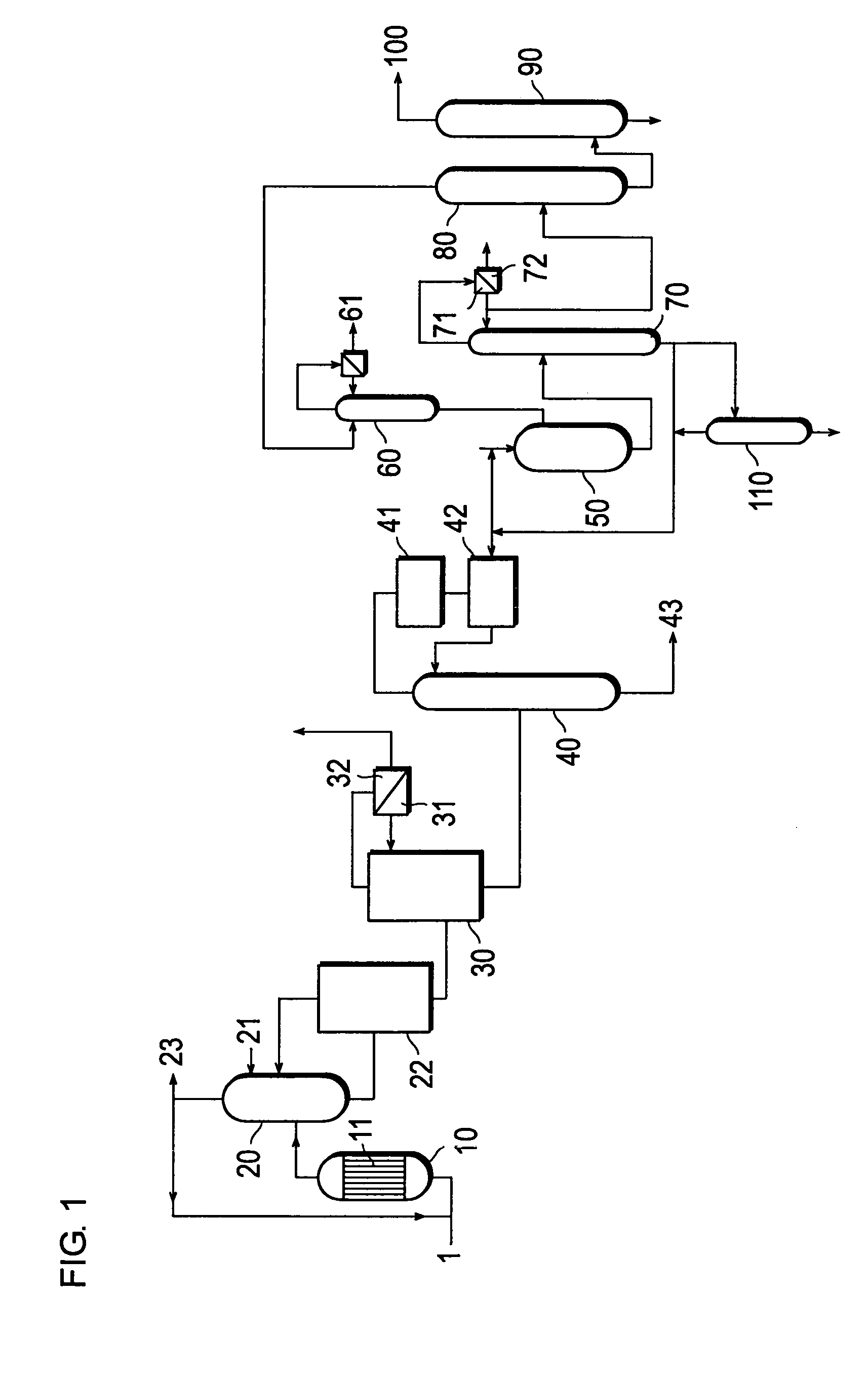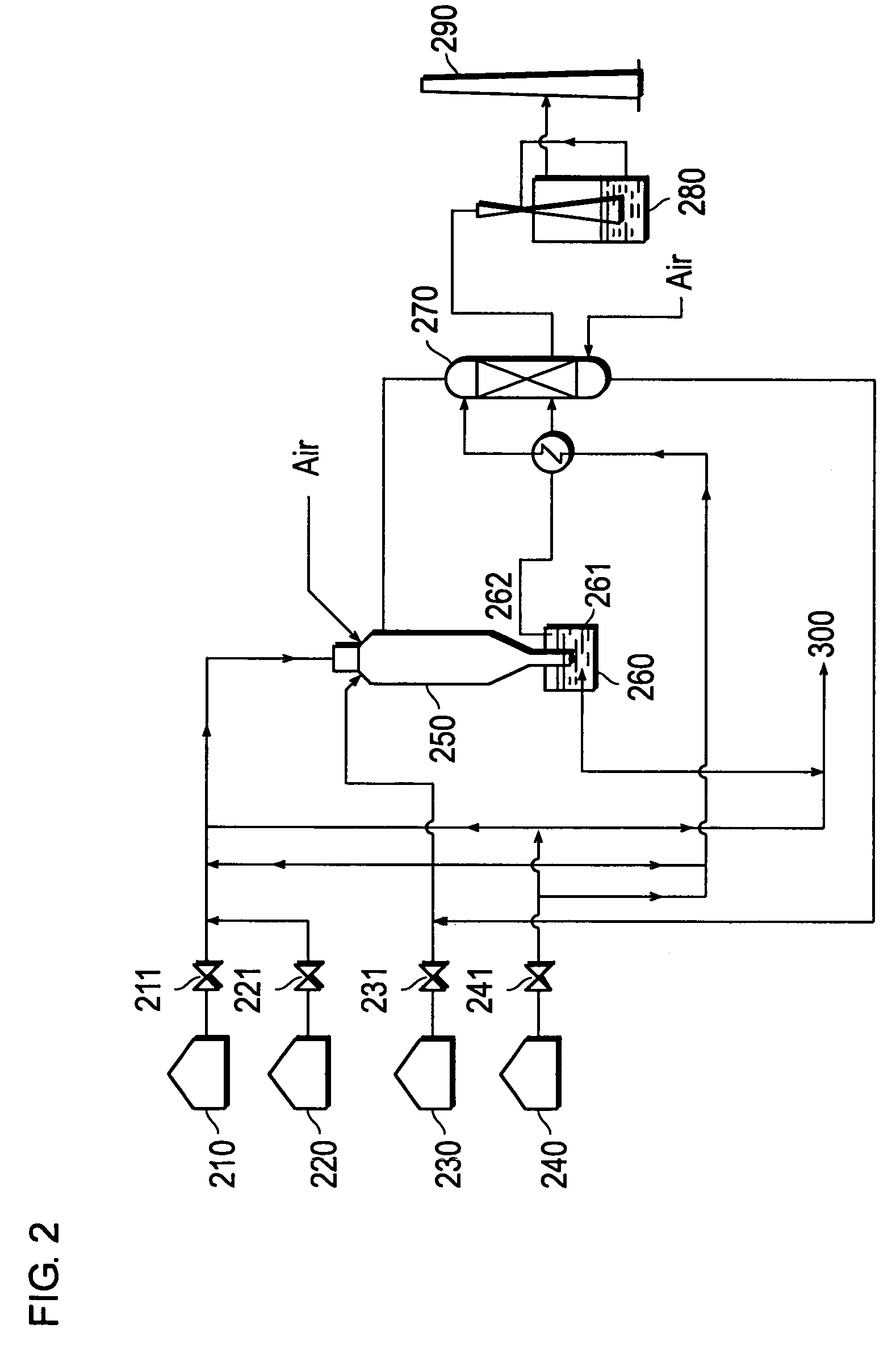Method for disposal of waste from acrylic acid process and acrylic ester process
a technology of acrylic acid and waste oil, which is applied in the direction of carboxylic acid esters, separation processes, combustion types, etc., can solve the problems of fuel waste, clogging of the piping of the device, and forming a deposit on the inner wall of the device, so as to ensure the smooth progress of combustion treatment and reduce the viscosity of waste oil. , the effect of high viscosity
- Summary
- Abstract
- Description
- Claims
- Application Information
AI Technical Summary
Benefits of technology
Problems solved by technology
Method used
Image
Examples
example 1
[0088]Acrylic acid and an acrylic ester were produced by following the procedure depicted in FIG. 1. First, a raw material gas containing propylene was subjected to gas phase oxidation to form an acrylic acid-containing gas. The gas was supplied to an absorption column and treated therein with water as an absorbent to absorb acrylic acid and consequent formation of an acrylic acid-containing solution. Then, the solution was supplied to an azeotropic dehydrating column and distilled therein in the presence of an azeotropic solvent to separate low boiling impurity through the top of the column. After the oil-aqueous separation, the aqueous phase 32 was obtained as waste water at a rate of 2.0 m3 / h. The bottom liquid of the azeotropic dehydrating column was supplied to a heavy-ends cut column and distilled therein to separate acrylic acid through the top of the column. When the bottom liquid 43 of the heavy-ends cut column was further concentrated with a thin film evaporator, a waste o...
example 2
[0093]An acrylic acid-containing gas was obtained by subjecting a raw material gas containing propylene to gas phase oxidation by following the procedure illustrated in FIG. 1 with necessary modifications. The gas was supplied to an absorption column and treated therein by the use of an absorbent to obtain an acrylic acid-containing solution. The absorption column emitted a gas containing 900 vol. ppm of acrylic acid and 20.8 vol. % of water at a rate of 610 Nm3 / min.
[0094]Then, similarly to the procedure of Example 1, the solution was supplied to the azeotropic dehydrating column and distilled therein in the presence of an azeotropic solvent to separate low boiling impurity via the top of the column. The bottom liquid of the azeotropic dehydrating column was supplied to a heavy-ends cut column and distilled therein to separate acrylic acid through the top of the column. The bottom liquid of the heavy-ends cut column was further concentrated in a thin film evaporator.
[0095]Part of th...
example 3
[0099]By following the procedure illustrated in FIG. 1 with necessary modifications, a raw material gas containing propylene was subjected to gas phase oxidation to produce an acrylic acid-containing gas. The gas was supplied to an absorption column and treated therein in the presence of an absorbent to obtain an acrylic acid-containing solution. The absorption column emitted a gas containing 900 vol. ppm of acrylic acid and 20.8 vol. % of water at a rate of 610 Nm3 / min through the top thereof.
[0100]Then, by following the procedure of Example 1, the solution was supplied to an azeotropic dehydrating column and distilled therein in the presence of an azeotropic solvent to separate a water-containing low boiling impurity through the top of the column. After the oil-aqueous separation, the aqueous phase was obtained as waste water at a rate of 1.7 m3 / h. The bottom liquid of the azeotropic dehydrating column was supplied to a heavy-ends cut column and distilled therein to separate acryl...
PUM
| Property | Measurement | Unit |
|---|---|---|
| temperature | aaaaa | aaaaa |
| temperature | aaaaa | aaaaa |
| temperature | aaaaa | aaaaa |
Abstract
Description
Claims
Application Information
 Login to View More
Login to View More - R&D
- Intellectual Property
- Life Sciences
- Materials
- Tech Scout
- Unparalleled Data Quality
- Higher Quality Content
- 60% Fewer Hallucinations
Browse by: Latest US Patents, China's latest patents, Technical Efficacy Thesaurus, Application Domain, Technology Topic, Popular Technical Reports.
© 2025 PatSnap. All rights reserved.Legal|Privacy policy|Modern Slavery Act Transparency Statement|Sitemap|About US| Contact US: help@patsnap.com


